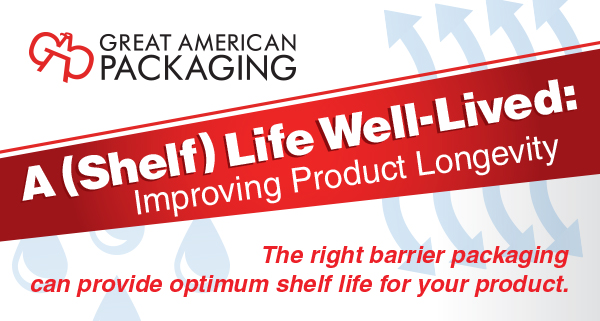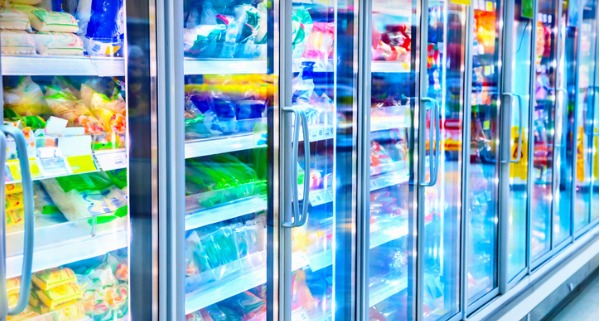BREATHE SHELF LIFE INTO YOUR PRODUCTS: A QUICK REFERENCE
GUIDE

Check out our newest infographic on how to extend the shelf life of products.
A snapshot of everything you need to know about barrier films.
DOWNLOAD A PDF OF THE SHELF LIFE INFOGRAPHIC.
READY TO CONTACT US?
Click HereOPTIMIZING SHELF LIFE
AND PRODUCT PRESENTATION

When new foods hit the grocery store shelves, manufacturers want them to stay fresh and appealing as long as possible. Shoppers, in turn, look for eye-catching items that scream delicious, convenient and healthy. The connection between the two: improved shelf life.
Innovations in food-product packaging have allowed food producers and retailers to showcase their items on the shelf for longer than ever before. For those looking to improve shelf life without sacrificing quality, it is important to understand the underlying science.
Understanding Shelf Life
Shelf life —the length of time a perishable product remains in good condition to be sold for consumption — is an essential part of food production. Shelf life represents happier customers, greater financial rewards, better environmental outcomes and increased food safety.
To determine shelf life, food manufacturers use sensory evaluations (testing taste, smell, sight and touch) and scientific methods. Shelf-life testing methods are approached in a variety of ways from informal studies to standardized, scientific testing in certified laboratories.
Shelf-life testing also includes determining and controlling elements that can contribute to spoilage.
Factors That Impact Shelf Life
When it comes to food shelf life, multiple factors —such as the mixture of ingredients, the local climate and storage conditions — affect freshness or promote spoilage.
- Ingredients: Despite having similar ingredients, banana bread from Brand X may have completely different storage needs than Brand Y banana bread.
- Climate: A food item made in California’s warm climate must be stored under different conditions than the same item made in Minnesota in the winter.
In general, these factors should be considered when determining a product’s shelf life and deciding on packaging:
- Transfer (or Transmission) Rates
The leading enemies of any packaged foods are oxygen and moisture. Packaging with oxygen- and moisture-barrier properties help foods stay fresher longer. Scientists use complicated mathematical formulas to determine transfer-rate data. The data is used to measure the permeability of oxygen or moisture through product packaging. More specifically:- Oxygen (OTR)
When foods are exposed to oxygen, the chemical makeup of the food can change. Some products require packaging that slowly releases oxygen, carbon dioxide and other gasses, known as off-gassing. Removing oxygen from packaging altogether before sealing can also slow the process of oxidation and inhibit bacteria growth. The oxygen transfer rate (OTR), or the amount of oxygen that permeates film packaging, helps to determine shelf stability. - Moisture (MVTR)
Moisture vapors can be the catalyst for microbial growth and food decay. Ideally, foodstuff should be kept at 15% humidity or lower to preserve quality. Air conditioning and packaging that regulates the moisture vapor transfer rate (MVTR) can protect food from spoilage.
- Oxygen (OTR)
- Light
Light, in either natural or artificial form, can break down nutrients and speed up spoilage. The process, called photodegradation, also causes food to change color or develop an unusual flavor. Blocking light, including UV rays, can help foods remain fresher longer. Packaging that stops light penetration supports food freshness and lengthens shelf life. - Temperature
Foods that are stored above or below optimal temperatures can hasten a limited shelf life. Dry storage temperatures should be kept between 50 degrees and 70 degrees. Foods stored in a freezer should reach an internal temperature of 0 degrees, and refrigerated foods should be kept between 32 degrees and 40 degrees. Hot food storage should be a minimum of 140 degrees.
With so many competing variables, food manufacturers often struggle with trying to find ways to improve shelf life and optimize shelf appeal.
Improving Shelf Life
In past decades, scientists have developed ways to maximize food shelf life: heating, pasteurization, chilling, additives and preservatives. Today, consumers want food that has been minimally processed. One solution to extending shelf life while satisfying consumer needs is flexible packaging.
Gone are the days when packaging was a mere afterthought of food production. Packaging increases shelf appeal and extends product life by maintaining an ideal environment for safeguarding freshness.
To optimize packaging for improved shelf life, manufacturers should understand the types of flexible barrier films:
- Monolayer films
Monolayer films consist of a single layer of LDPE, LLDPE, high density PE or polypropylene, to name a few.- Economical choice
- Allows for a small amount of permeability
- Good to moderate OTR, MVTR for products that require film with some permeability
- Protects against oily or greasy residue transfer
- Highly recyclable
- Multilayer films
Multilayer films consist of multiple substrate layers. PET, OPP, EVOH, PE, nylon or other films are joined to create a single strong and flexible film.- Offers high OTR and WVTR barrier protections
- Manufactured in one of two ways: co-extruded (separate polymer layers are joined during the extrusion process and cast or blown into a single multilayer film) and laminated (multiple film layers are bonded with an adhesive)
- Multilayer Films combining different substrates are not recyclable
Other performance properties to consider when choosing the right flexible packaging for your product include:
- Puncture Resistance
Improves puncture resistance to withstand sharp edges and objects - Freezer safety
Keeps items safe from freezer burn - Recyclable
Capable of processing for reuse - Printable
Develops improved branding for retail display - Clarity
Improves retail shelf appeal and display of the product inside - Sealable
Enhances the quality of the bag to protect the products inside and improves efficiencies during the packaging process. - Barrier
Optimizes the OTR and WVTR for the product inside - Film stiffness
Improves retail display options and shelf appeal (especially for stand-up pouches)
In addition, manufacturers of perishable products must keep in mind the type of transportation and retail storage to determine the type of packaging needed.
Studies show that more than half of customers (55%) make purchasing decisions while strolling store aisles. Improving shelf life and packaging is beneficial for manufacturers, retailers and consumers, alike.
The team at Great American Packaging understands how to partner with customers to identify the ideal packaging for every product. After 50 years in business, the Los Angeles-based company is still family owned and proud to maintain its core beliefs in customer collaboration, problem-solving and adherence to industry-best standards.
The Great American Packaging Company team is always ready to assist with any package extruding, flexographic printing, converting (bag making) and consulting needs. Contact us today at 877-BUY-BAGS (877-289-2247) or simply fill out the contact form below.
WE ARE GFSI CERTIFIED!

Great American Packaging is proud to be an IFS PacSecure certified facility – with a 97% rating. Our GFSI-recognized certification means clients can be sure that their packaging materials meet regulatory and safety standards. IFS facilitates B2B trade and helps improve product integrity along the entire supply chain.
Contact
"*" indicates required fields


